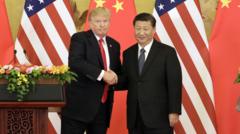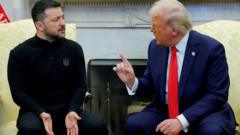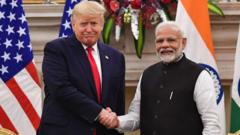Trade officials from the US and China prepare to meet in Switzerland, marking the first significant discussion since the escalation of tariffs. Both parties face pressure as their economies feel the repercussions of prolonged trade hostilities, with calls for a practical approach to negotiations despite deep-seated issues.
US and China on the Path to Dialogue: A Turn in Trade Relations?

US and China on the Path to Dialogue: A Turn in Trade Relations?
High-level talks between the US and China signal a potential easing of trade tensions amid competing narratives surrounding responsibility for negotiations.
The trade standoff between the US and China may be nearing a turning point, with negotiations scheduled to take place in Switzerland this weekend. This marks the first significant dialogue since the instatement of heavy tariffs by US President Donald Trump in January, leading to a tense back-and-forth where both nations imposed levies on each other's imports; the current tariffs stand at 145% for US imports from China and 125% on US exports to China.
Recent weeks have been rife with sharp rhetoric as both sides aimed to cast the other as more desperate. Yet, as top officials prepare to convene, questions linger about why these discussions are occurring now. Senior trade expert Stephen Olson of the ISEAS-Yusof Ishak Institute noted that both countries seem to have concluded they can negotiate without appearing to yield, a delicate balance in a landscape characterized by fierce competition.
As tensions built, China indicated that these talks were initiated at the behest of US officials, with the commerce ministry positioning the negotiations as a response to American business pressures. Contrarily, Trump emphasized claims that it is China which seeks better relations due to a faltering economy, albeit adopting a more conciliatory tone as talks approached. "What happens in that room is ultimately what matters," he remarked, downplaying the origins of the discussion.
Additionally, the timing coincides with Chinese leader Xi Jinping's visit to Moscow, where he highlighted China's global role beyond US economic influence. This move could bolster Beijing's confidence as both nations come to the table to negotiate.
The dual impact of tariffs is tangible. Reports indicate a decline in China's manufacturing output, with recent data showing low activity levels since December 2023. Concerns about collapsed supply chains in the US have sparked alarm among businesses reliant on Chinese goods. Trump acknowledged the challenge, indicating that rising prices may soon be felt by American consumers through higher product costs and diminishing choices.
With the May Day holiday concluded, China appears ready to engage in talks, recognizing that a sustainable agreement could benefit both parties. While there is hope for progress, experts caution that substantial agreements will likely take time and may only focus on preliminary discussions at this meeting.
The initial conversations in Geneva are expected to frame future talks without immediate resolution of enduring issues like subsidies and the overall tariff landscape. The prospect of a more robust agreement rests on addressing deep-rooted tensions, but anticipation remains high. Experts predict "anodyne statements" about future commitments rather than concrete breakthroughs.
Despite the long road ahead, this meeting could mark a crucial step in redefining US-China relations amidst shifting global dynamics.






















